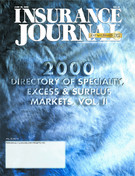Chalk up 2000 as another year for making great strides in passing legislation relating to deregulation. Since 1997, 21 states have passed laws deregulating commercial lines to one degree or another. “In 2000, we had seven additional states, so we’re seeing a trend that has continued through the last two years,” said Rita Nowak, assistant vice president, Alliance of American Insurers (Alliance).
The goal of deregulation is to streamline the regulatory process for insureds, insurers and regulators. Commercial deregulation allows regulators to be responsive to consumers rather than having to stretch limited resources.
Under most states’ guidelines, the large commercial policyholders gain the most from deregulation, but there are variations of “large, sophisticated commercial insurance policyholders.” The criteria for an “exempt” policyholder include such things as asset size, number of employees, premium levels, and employment of a full-time, in-house risk manager.
“The particulars on monetary thresholds for aggregate premium have been set all over the map…each state is different,” said John Marlow, public affairs director for the Southwest region, American Insurance Association (AIA).
Nowak agreed, and said that this year brought with it a lot of variation in the criteria to qualify for the exemption. “We see some states with a very low threshold and others with a very high threshold,” she said.
The Alliance believes that there is still potential that one more state-the District of Columbia-will reduce government regulation of commercial insurance. “D.C. is looking at a very streamlined set of criteria, probably one of the best for year 2000,” Nowak said. “But again, it’s pending legislation.”
Essentially, D.C. Bill 13-724 (Insurance Economic Development Act of 2000) exempts large, sophisticated commercial policyholders from rate and form regulation. The primary purpose of the legislation is to improve the business climate in D.C. by increasing competition through reducing the amount of time it takes insurers to enter markets and develop new products.
“The Department is very much into minimizing regulatory barriers, trying to get products to market, so we’re very positive on that bill in regards to the outcome,” Nowak added.
Two pieces of the puzzle
Two of the most important issues when discussing commercial deregulation are rates and forms. “We’ve had a great deal of success on enacting rate reform legislation in a number of states, and the majority of laws that were enacted in ’98 and ’99 had to do with rate filings and establishing the large commercial risk exemption for rate filings,” Marlow said. “This has opened up a very competitive commercial lines market.”
Meanwhile, on the forms side, things have been a little bit slower. “There has been some political opposition to deregulating policy forms primarily from agents’ associations in individual states,” Marlow said. “They have some concerns that their agents may be opened up to some error and omission [E&O] liability should a policyholder not be fully advised of what’s in his policy form if those forms are deregulated.”
Yet, in the states that have policy form deregulation, Marlow said there hasn’t been a “groundswell” of problems in that regard. “Truth be known, the majority of E&O cases that are filed suit on every year usually take place on the personal lines side,” he said.
A survey by the Insurance Research Council (IRC) revealed that the majority of firms with sales between $5 million and $100 million believe they could negotiate a lower premium for their commercial insurance under competition than under state regulation. In fact, the majority of the companies surveyed (53 percent) believe they will receive more customized insurance rates and coverage in a deregulated environment.
According to Robert Zeman, vice president and assistant general counsel of the National Association of Independent Insurers (NAII), about half the state legislation addresses both rates and forms, while the remainder addresses only one of these components.
Zeman also pointed out that in most states the exemption applies to filing requirements only. He identified Arizona, Maine and Illinois as three states that have taken a broader view toward deregulation by exempting rates and forms from both filing requirements and underlying regulation.
States setting examples
Georgia (which took regulatory action last year) has set a trend that could help the case for commercial deregulation, according to Nowak. “The Department was exempting a certain class of the commercial consumer from rate and form filing,” she said. “They are now proposing…decreases in the various financial size criteria so that there will be more impact to the consumer. What we’re hoping to see is as states are becoming more comfortable with this process, they will look at further application of the exempt status to more consumers in the commercial lines market.”
Marlow described Colorado and Louisiana (both passed forms legislation last year) as states that took a different approach in how they established the threshold for exemption. “They allowed the Commissioner of Insurance to establish the definition through the regulatory process rather than putting the definition of the exemption in the statute where it’s very concrete and very hard to change with any expediency,” he said. “By doing it through the regulatory process, you hold public hearings, you study market data, plus you also know about the number of filings that are coming through your own department. That way, you are able to react more fluidly to the demands of the market.”
From all reports, Marlow said, this seems to have worked well for both Colorado and Louisiana. “It’s an approach that’s been considered in other states, but I don’t believe it’s been enacted anywhere yet,” he added.
Speed to Market initiative
As one of its priorities for 2000, the National Association of Insurance Commissioners (NAIC) is working with governors and state legislators to take steps to improve speed to market for insurance products. This will include development and implementation of a system of deference to the state of domicile using one-stop filing for products issued on a multi-state basis, where appropriate.
As a result, the NAIC has a working group dedicated to Speed to Market. At the group’s meeting, the Alliance urged the Commissioners to build on the momentum that’s already at the state level in regards to commercial lines. NAII’s Zeman also believes the NAIC’s Speed to Market initiative should be commended and supported by the industry.
“They are looking for things that can get an immediate bang, and in our opinion, the momentum has been there for almost three years,” Nowak said.
The Alliance suggested that the Commissioners look at what’s going on at the commercial level, and either implement regulations for the large commercial risks and/or lower the thresholds in the states that have already implemented some type of commercial reform.
Winning to the fourth power
Marlow feels that commercial lines deregulation is an absolute four-way win. “Four wins because you have insurers, agents, policyholders and regulators, and all four, I think, have seen the benefits of deregulation working in each of their favors thus far,” he said.
The AIA’s job is to tell the success stories of states that have seen their way clear to enact forms legislation, Marlow said. “They need to know that the sky has not fallen, that agents are not being sued out of existence and that the insurance market continues to change with financial services modernization,” Marlow said. “And that deregulation and opening up and giving insurers the ability to develop and innovate products.”
NAIC Vice President and Kansas Insurance Commissioner Kathleen Sebelius shared her perspective on commercial lines deregulation efforts with IJ.
“I think that the deregulation efforts in Kansas have been beneficial because it has helped insurers view our state as a better place to do business and ultimately will produce, I think, lower prices, more competition and more choices for consumers,” she said. “So getting rid of some of the regulatory barriers- which slow down the marketplace, add cost to the product, and may, in a small-premium volume state like ours, actually make some of the national companies more hesitant to come to Kansas-I think can really be a win-win situation. It’s more cost effective for insurers to do business and the result is that consumers are the beneficiaries.”
The Alliance’s Nowak said that they expect to see more states attack this issue in 2001. “Since this initiative started, we have 21 states that have enacted or adopted a regulation,” she said. “So now we would like to see some of these states go further and we’d like to see some more states get on board.”
Topics Trends Carriers Legislation Commercial Lines Business Insurance
Was this article valuable?
Here are more articles you may enjoy.


 Trump to Issue Order Creating National AI Rule
Trump to Issue Order Creating National AI Rule  Death at Universal’s Orlando Resort Roller Coaster Ruled Accidental
Death at Universal’s Orlando Resort Roller Coaster Ruled Accidental  Insurance Covers Settlement Paid by Stocks Instead of Money: Delaware High Court
Insurance Covers Settlement Paid by Stocks Instead of Money: Delaware High Court  McKinsey Plots Thousands of Job Cuts in Slowdown for Consulting Industry
McKinsey Plots Thousands of Job Cuts in Slowdown for Consulting Industry 


